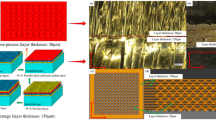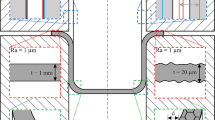Abstract
In this work, a robust tool-drop algorithm coupled with the bisection method is used to speed up the computations in the drop and tilt method (DTM), a multipoint tool positioning technique for 5-axis machining with a toroidal end mill. In the DTM, the tool is dropped on the surface along a predetermined tool-axis direction until it touches the surface tangentially. The position of the circular tool insert (pseudo-insert circle) through the first point of contact is then used to compute the tool-tilt angle that causes the tool to touch the surface tangentially at a second point. A previous implementation of DTM used Newton’s method to solve the system of equations for tilting the tool, but took many iterations and multiple initial seed solutions to converge to a valid solution for tool-tilt orientation. Using the bisection method coupled with the generalized tool-drop algorithm instead of a direct use of Newton’s method to determine the tool-tilt angle improves performance without compromising the accuracy. The method was implemented in C+ +, and a comparative study with an earlier method for several bi-quadratic and bi-cubic Bézier surfaces demonstrates the reliability of the developed method.
Similar content being viewed by others
References
Bedi S, Ismail F, Mahjoob MJ, Chen Y (1997) Toroidal versus ball nose and flat bottom end mills. Int J Adv Manuf 13(5):326–332
Yaua HT, Chuanga CM, Lee YS (2004) Numerical control machining of triangulated sculptured surfaces in a stereo lithography format with a generalized cutter. Int J Prod Res 42(13):2573–2598
Lasemi A, Xue D, Gu P (2010) Recent development in CNC machining of freeform surfaces: a state-of-the-art review. Comput-Aided Des 42:641–654
Patel K, Bolanos GS, Bassi R, Bedi S (2011) Optimal tool shape selection based on surface geometry for three-axis CNC machining. Int J Adv Manuf Technol 57:655–670
Roth D, Ismail F, Bedi S (2005) Mechanistic modelling of the milling process using complex tool geometry. Int J Adv Manuf Technol 25:140–144
Warkentin A, Ismail F, Bedi S (2000) Comparison between multi-point and other 5-axis tool positioning strategies. Int J Mach Tools Manuf 40(2):185–208
Rao N, Bedi S, Buchal R (1996) Implementation of the principal-axis method for machining of complex surfaces. Int J Adv Manuf Technol 11(4):249–257
Rao N, Ismail F, Bedi S (1997) Tool path planning for five-axis machining using the principal axis method. Int J Mach Tools Manuf 37(7):1025–1040
Bedi S, Gravelle S, Chen Y (1997) Principal curvature alignment technique for machining complex surfaces. J Manuf Sci Eng 119(4B):756–765
Warkentin A, Ismail F, Bedi S (1998) Intersection approach to multi-point machining of sculptured surfaces. Comput Aided Geom Des 15:567–584
Warkentin A, Ismail F, Bedi S (2000) Multi-point tool positioning strategy for 5-axis machining of sculptured surfaces. Comput Aided Geom Des 17(1):83–100
Gray P, Ismail PF, Bedi S (2004) Graphics-assisted rolling ball method for 5-axis surface machining. Comput-Aided Des Elsevier 36:653–663
Gray P, Bedi S, Ismail F (2005) Arc-intersect method for 5-axis tool positioning. Comput-Aided Des Elsevier 37:663–674
Hosseinkhani Y, Akbari J, Vafaeesefat A (2007) Penetration–elimination method for five-axis CNC machining of sculptured surfaces. Int. J Mach Tools Manuf eElsevier 47:1625–1635
Duvedi RK, Bedi S, Batish A, Mann S (2015) Numeric implementation of drop and tilt method of 5-axis tool positioning for machining of STL surfaces. Int J Adv Manuf Technology Springer, London 78(9–12):1677–1690
Duvedi RK, Bedi S, Batish A, Mann S (2016) The edge–torus tangency problem in multipoint machining of triangulated surface models. The Int J Adv Manuf Technol 82(9):1959–1972
Duvedi RK, Bedi S, Batish A, Mann S (2014) A multipoint method for 5-axis machining of triangulated surface models. Comput-Aided Des 52:17–26
Duvedi RK, Bedi S, Mann S (2017) Drop and tilt method of 5-axis tool positioning for tensor product surfaces. Int J Adv Manuf Technol 93(1–4):617–622
Duvedi RK, Bedi S, Mann S (2017) Numerical implementation of drop and tilt method of 5-axis tool positioning for tensor product surfaces. Accepted in Int J Adv Manuf Technol. Springer, London. https://doi.org/10.1007/s00170-017-1193-1
Farin G (1997) Curves and surfaces for computer aided geometric design, 4th edn. Academic, New York
Duvedi R, Batish A, Bedi S, Mann S (2015) Scallop height of 5-axis machining of large triangles with a flat end mill. Comput-Aided Des Appl. https://doi.org/10.1007/s00170-014-6636-3
Funding
This research was funded by the Natural Sciences and Engineering Research Council of Canada.
Author information
Authors and Affiliations
Corresponding author
Additional information
Publisher’s Note
Springer Nature remains neutral with regard to jurisdictional claims in published maps and institutional affiliations.
Appendix: Newton’s method
Appendix: Newton’s method
Newton’s method iteratively computes the value of an error function \(F(X, \hat {t},T)\) by numerically estimating the values of X = [u,v,h] to obtain the solution for the point of contact between the dropping toroidal tool and the surface S(u,v). The error function solved using Newton’s method for tool drop for is
For the set of three non-linear simultaneous rational equations given by \(F(X, \hat {t}, T)=[F.x, F.y, F.z]\) the forward difference approximation of the derivative is
Knowing a value of X i , the value of Xi+ 1 for which \(F(X_{i + 1}, \hat {t}, T)= 0\) is
where J is the Jacobian matrix:
The elements of the Jacobian J are the partial derivatives of the x,y, and z components of \(F(X, \hat {t}, T)\) with respect to u,v, and h; their expansions are given in Appendix A.2.
The pseudocode for Newton’s method is given in Fig. 13.
1.1 A.1 Upper bound number of iterations in Newton’s algorithm
Newton’s method is sensitive to the initial seed values of surface parameters (u,v) and for a given initial seed solution X i = [u i ,v i ,h i ], it may not yield required solution for the point of contact within the bounds of the Bézier surface given by u m i n ≤ u ≤ u m a x and v m i n ≤ v ≤ v m a x . Thus, an upper bound on the number of iterations used in Newton’s method, num N , is required. If Newton’s method fails to converge to a solution within num N iterations then the search for the solution is stopped and Newton’s algorithm is re-initiated with a new initial seed solution as given in line 4.5.b of the pseudocode for tool-tilt in Fig. 6.
To compare the computational efficiency of the bisection DTM with the direct numerical DTM version [19] the upper bound for num N is kept at 50. The comparison of the number of iterations used by Newton’s method in the vertical tool drop (to determine the first point of contact) and the tilted-axis drop in the numerical DTM and the bisection-based DTM (to compute the second point of contact) is given in Tables 6 and 7. For computing first point of contact, most valid solutions of Newton’s algorithm converged within 29 iterations while in case of computing the second point of contact (using both bisection DTM as well as direct numerical DTM) the maximum number of iterations were as high as 50.
1.2 A.2 Jacobian matrix for Newton’s method
The elements of Jacobian J matrix are the derivatives of x,y, and z components of \(F(X, \hat {t}, T)\) with respect to variables u,v, and h. These derivative terms may have complex expressions depending on the order of the given part surface and need to be determined with significant accuracy. The mathematical expressions of various Jacobian terms are given as:
where
where
and \(j(u,v)=[T-S(u,v)-\{(T-S(u,v))\cdot \hat {t}\}\cdot \hat {t}]\).
Rights and permissions
About this article
Cite this article
Duvedi, R.K., Bedi, S. & Mann, S. An efficient multipoint 5-axis tool positioning method for tensor product surfaces. Int J Adv Manuf Technol 97, 279–295 (2018). https://doi.org/10.1007/s00170-018-1940-y
Received:
Accepted:
Published:
Issue Date:
DOI: https://doi.org/10.1007/s00170-018-1940-y





